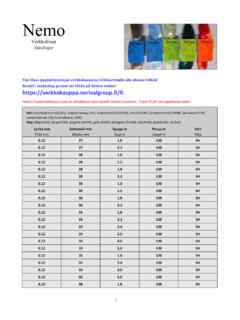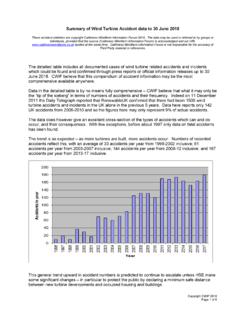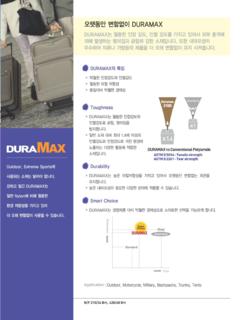Transcription of Mexico: Organized Crime and Drug Trafficking Organizations
1 Mexico: Organized Crime and Drug Trafficking Organizations June S. Beittel Analyst in Latin American Affairs April 25, 2017 congressional research Service 7-5700 R41576 Mexico: Organized Crime and Drug Trafficking Organizations congressional research Service Summary The notorious drug Trafficking kingpin Joaqu n El Chapo Guzm n is now imprisoned in the United States awaiting trial, following the Mexican government s decision to extradite him to the United States on January 19, 2017, the day before President Trump took office.
2 Guzm n is charged with operating a continuing criminal enterprise and conducting drug-related crimes as the purported leader of the Mexican criminal syndicate commonly known as the Sinaloa cartel. The Drug Enforcement Administration (DEA) maintains that the Sinaloa cartel has the widest reach into cities of any transnational criminal organization. In November 2016, in its National Drug Threat Assessment, the DEA stated that Mexican drug Trafficking groups are working to expand their presence, particularly in the heroin markets inside the United States.
3 Over the years, Mexico s criminal groups have trafficked heroin, methamphetamine, cocaine, marijuana, and increasingly the powerful synthetic opioid fentanyl. Mexico s drug Trafficking Organizations (DTOs) have been in constant flux. By some accounts, in 2006, there were four dominant DTOs: the Tijuana/Arellano Felix organization (AFO), the Sinaloa cartel, the Ju rez/Vicente Carillo Fuentes organization (CFO), and the Gulf cartel. Since then, the more stable large Organizations have fractured. In recent years, the DEA has identified the following Organizations as dominant: Sinaloa, Los Zetas, Tijuana/AFO, Ju rez/CFO, Beltr n Leyva, Gulf, and La Familia Michoacana.
4 In some sense, these Organizations might be viewed as the traditional DTOs, although the 7 Organizations appear to have fragmented to at least 9 (or as many as 20) major Organizations . New Crime groups have emerged since the December 2012 inauguration of Mexican President Enrique Pe a Nieto, who has faced an increasingly complex Crime situation. The major DTOs and new Crime groups have furthered their expansion into such illicit activity as extortion, kidnapping for ransom, and oil syphoning, posing a governance challenge to President Pe a Nieto as daunting as that faced by his predecessors.
5 Former Mexican President Felipe Calder n (2006-2012) initiated an aggressive campaign against Mexico s drug traffickers that was a defining policy of his government and one that the DTOs violently resisted. Operations to eliminate DTO leaders sparked organizational change, which led to significant instability among the groups and continued violence. Such violence appears to be rising again in Mexico. In January 2017, the country registered more homicides than in any January since the government began to release national Crime data in the late 1980s.
6 In a single weekend in April 2017, more than 35 died in what was assumed to be drug Trafficking -related violence. Although the Mexican government no longer estimates Organized Crime -related homicides, some independent analysts have claimed that murders linked to Organized Crime may have exceeded 100,000 since 2006, when President Calder n began his campaign against the DTOs. Mexico s government reported that the annual number of all homicides in Mexico declined after Calder n left office in 2012 by about 16% in 2013 and 15% in 2014, only to rise in 2015 and 2016.
7 In 2016, the Mexican government reported a 22% increase in all homicides to 22,932, almost reaching the high point of nearly 23,000 murders in 2011, Mexico s most violent year. The 115th Congress remains concerned about security conditions inside Mexico and the illicit drug trade. The Mexican DTOs are the major wholesalers of illegal drugs in the United States and are increasingly gaining control of retail-level distribution. This report examines how the Organized Crime landscape has been significantly altered by fragmentation and how the organizational shape-shifting continues.
8 For more background, see CRS Report R41349, Security Cooperation: The M rida Initiative and Beyond, and CRS In Focus IF10400, Heroin Production in Mexico and Policy. Mexico: Organized Crime and Drug Trafficking Organizations congressional research Service Contents Background .. 1 congressional Concerns .. 3 Crime Situation in Mexico .. 5 Background on Drug Trafficking in Mexico .. 6 Evolution of Mexico s Major Drug Trafficking Organizations .. 9 Nine Major DTOs .. 9 Tijuana/Arellano Felix Organization (AFO).
9 12 Sinaloa DTO .. 13 Ju rez/Carrillo Fuentes Organization .. 15 Gulf DTO .. 16 Los Zetas .. 17 Beltr n Leyva Organization (BLO) .. 19 La Familia Michoacana (LFM) .. 20 Knights Templar .. 21 Cartel Jalisco-New Generation (CJNG) .. 22 DTO Fragmentation, Competition, and Diversification .. 24 Outlook .. 28 Figures Figure 1. Map of Mexico .. 5 Figure 2. 2015 Map of DTO Areas of Dominant Influence Developed by the Drug Enforcement Administration .. 11 Figure 3. Mexico Cartel Map for 2016 .. 26 Tables Table 1.
10 Drug Trafficking Organizations Typology .. 27 Contacts Author Contact Information .. 29 Mexico: Organized Crime and Drug Trafficking Organizations congressional research Service 1 Background Mexico s stability is of critical importance to the United States, and the nature and intensity of violence in Mexico has been of particular concern to the Congress. Mexico shares a nearly 2,000-mile border with the United States, and the two countries have close trade, cultural, and demographic ties. In addition to concern about this strategic partner and close neighbor, policymakers have expressed concern that the violence in Mexico could spill over into border states (or further inland) despite beefed-up security measures.
















